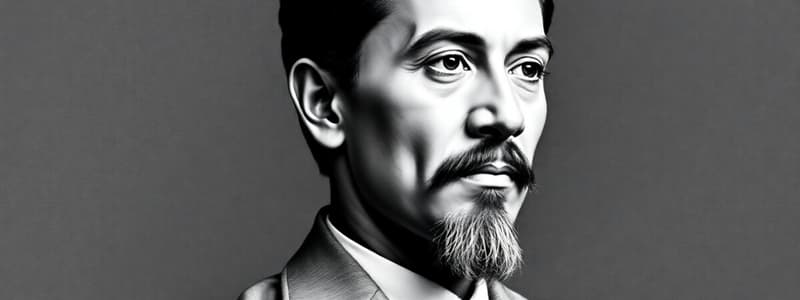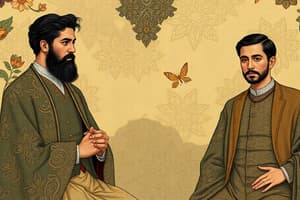Podcast
Questions and Answers
Who served as the first president of the Philippine Commonwealth?
Who served as the first president of the Philippine Commonwealth?
- Camilo Osias
- Renato Constantino
- Manuel L. Quezon y Molina (correct)
- José Paciano Laurel
Camilo Osias was a strong advocate for academic freedom and civil liberties.
Camilo Osias was a strong advocate for academic freedom and civil liberties.
True (A)
What was the key focus of Renato Constantino's nationalism?
What was the key focus of Renato Constantino's nationalism?
Nationalism as a reality of having a country of our own that must be kept independent.
José Paciano Laurel served as president of the Philippines during the ______ occupation.
José Paciano Laurel served as president of the Philippines during the ______ occupation.
Match the following figures with their respective areas of focus:
Match the following figures with their respective areas of focus:
Which of these individuals believed in a 'bottom-up' economic approach?
Which of these individuals believed in a 'bottom-up' economic approach?
Manuel L. Quezon y Molina believed in a system where the government should ensure equal distribution of wealth.
Manuel L. Quezon y Molina believed in a system where the government should ensure equal distribution of wealth.
What was the main goal of the Tydings-McDuffie Act, which Manuel L. Quezon y Molina fought for?
What was the main goal of the Tydings-McDuffie Act, which Manuel L. Quezon y Molina fought for?
Which artistic styles did Esquivel Embuscado aim to dissociate from in his art movement?
Which artistic styles did Esquivel Embuscado aim to dissociate from in his art movement?
Esquivel Embuscado's art movement, Dissectionism, prioritized the individual parts of art rather than their interconnectedness.
Esquivel Embuscado's art movement, Dissectionism, prioritized the individual parts of art rather than their interconnectedness.
What was the name of the manifesto launched by Esquivel Embuscado for his art movement?
What was the name of the manifesto launched by Esquivel Embuscado for his art movement?
Isabela Delos Reyes established the first labor federation in the Philippines called the ______.
Isabela Delos Reyes established the first labor federation in the Philippines called the ______.
Match the following individuals with their respective contributions:
Match the following individuals with their respective contributions:
Isabela Delos Reyes's rebellious spirit stemmed from his positive experiences with the friar-professors at the Seminary of Vigan.
Isabela Delos Reyes's rebellious spirit stemmed from his positive experiences with the friar-professors at the Seminary of Vigan.
What is the name of the two-volume work compiled by Isabela Delos Reyes that focused on Filipino customs and traditions?
What is the name of the two-volume work compiled by Isabela Delos Reyes that focused on Filipino customs and traditions?
What was the primary goal of the Katipunan, founded by Andrés Bonifacio?
What was the primary goal of the Katipunan, founded by Andrés Bonifacio?
José Rizal's novel Noli me Tangere was published in 1896.
José Rizal's novel Noli me Tangere was published in 1896.
Why was the execution of the Gomburza, a group of Filipino priests, a significant event in the development of Filipino nationalism?
Why was the execution of the Gomburza, a group of Filipino priests, a significant event in the development of Filipino nationalism?
Emilio Jacinto's influential work, the [BLANK], outlines the ideals and principles of the Katipunan.
Emilio Jacinto's influential work, the [BLANK], outlines the ideals and principles of the Katipunan.
Match the following Filipino social thinkers with their primary contributions:
Match the following Filipino social thinkers with their primary contributions:
Which of these statements accurately describes the concept of 'social thought' as defined by Emory S. Bogardus?
Which of these statements accurately describes the concept of 'social thought' as defined by Emory S. Bogardus?
Emilio Jacinto advocated for a gradual, peaceful approach to achieving Philippine independence.
Emilio Jacinto advocated for a gradual, peaceful approach to achieving Philippine independence.
Explain the significance of La Solidaridad in the context of Filipino social thought.
Explain the significance of La Solidaridad in the context of Filipino social thought.
Flashcards
Social Thought
Social Thought
Ideas and beliefs individuals develop to understand society.
Filipino Social Thought
Filipino Social Thought
Nationalistic ideas emphasizing history and freedom in the Philippines.
José Rizal
José Rizal
Patriot and key figure in the Philippine nationalist movement.
Reformist
Reformist
Signup and view all the flashcards
Andrés Bonifacio
Andrés Bonifacio
Signup and view all the flashcards
Katipunan
Katipunan
Signup and view all the flashcards
Emilio Jacinto
Emilio Jacinto
Signup and view all the flashcards
Cavite Mutiny
Cavite Mutiny
Signup and view all the flashcards
Manuel L. Quezon
Manuel L. Quezon
Signup and view all the flashcards
Tydings-McDuffie Act
Tydings-McDuffie Act
Signup and view all the flashcards
José Paciano Laurel
José Paciano Laurel
Signup and view all the flashcards
Renato Constantino
Renato Constantino
Signup and view all the flashcards
Nationalism
Nationalism
Signup and view all the flashcards
Camilo Osias
Camilo Osias
Signup and view all the flashcards
Colonial Experience
Colonial Experience
Signup and view all the flashcards
Economic Approach
Economic Approach
Signup and view all the flashcards
Dissectionism
Dissectionism
Signup and view all the flashcards
Esquivel Embuscado
Esquivel Embuscado
Signup and view all the flashcards
Makabagong tumpak sining
Makabagong tumpak sining
Signup and view all the flashcards
Isabelo Delos Reyes
Isabelo Delos Reyes
Signup and view all the flashcards
Union de Impresores de Filipinas
Union de Impresores de Filipinas
Signup and view all the flashcards
Aglipay Church
Aglipay Church
Signup and view all the flashcards
El Ilocano
El Ilocano
Signup and view all the flashcards
El Folk-Lore Filipino
El Folk-Lore Filipino
Signup and view all the flashcards
Study Notes
Filipino Social Thinkers
- Social Thought
- Proponent: Emory S. Bogardus
- Refers to the ideas, beliefs, and perspectives that individuals & groups develop to understand and interpret social phenomena, structure, and relationships.
- Filipino Social Thought
- The Filipino sense of history and nationalism (focused on freedom).
- The emergence of the shared consciousness and revolution came in the form of the Cavite Mutiny and the execution of the GomBurZa.
Reformist
- 1. José Protasio Rizal Mercado y Alonso Realonda (Better known as: José Rizal)
- Born June 19, 1861, Calamba, Philippines—died December 30, 1896, Manila.
- Patriot, physician, and man of letters who was an inspiration to the Philippine nationalist movement.
- He contributed numerous articles to its newspaper, La Solidaridad, published in Barcelona.
- Leader of the Propaganda Movement.
- Question: Why was José Rizal called a Reformist?
- Answer: José Rizal can be considered a reformist. He aimed to expose the social ills of his time through his novels and writings, reflecting his critique of Philippine society. Rizal was a key member of the Filipino Propaganda Movement, advocating for political reforms under Spanish colonial rule.
Revolutionist
- 1. Andrés Bonifacio
- Born November 30, 1863, Manila—died May 10, 1897, Mt. Buntis, Phils.
- Philippine patriot, founder and leader of the advocated complete independence from Spain.
- In 1892, he founded the Katipunan in Manila, modelling its organization and ceremony on that of the Masonic order.
- His philosophy of revolution was published in the revolutionary newspaper, "Kalayaan".
- Founder of the revolutionary society
- Authored essays such as "Ang Dapat Mabatid ng mga Tagalog" and poem "Pag-ibig sa Tinubuang Lupa", these literary works encourage Filipinos to show patriotism and love for country.
- 2. Emilio Jacinto
- Born December 15, 1875, Manila
- Son of a prominent merchant.
- Received good education and was fluent in both Tagalog and Spanish.
- Served as the spokesperson for the Katipunan, penned the official handbook of the movement, called the Kartilya ng Katipunan.
- Revolutionist, patronized the ideals of liberty, equality, and brotherhood.
Studying That Suits You
Use AI to generate personalized quizzes and flashcards to suit your learning preferences.




